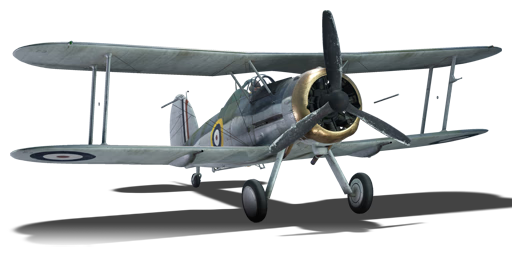



The Gloster Sea Gladiator was a naval modification of the Gladiator biplane fighter in use by the Royal Air Force (RAF). 98 Sea Gladiators were completed: 38 "interim" airframes were modified from the existing Gladiator Mk II. Differences from the Gladiator Mk IIs in service with the RAF included the planes being fitted with catapult attachment points and a tail hook, the airframe being strengthened to withstand carrier landings, and a dinghy lifeboat being made mountable to the underbelly of the plane. It was powered by a nine-cylinder Bristol Mercury VIIA radial engine rated at 840 hp and mated to a three-blade Fairey metal fixed pitch propeller, while retaining the same armament as the Gladiator Mk.II.
It was introduced in Update 1.49 "Weapons of Victory". The Sea Gladiator Mk I is the last of the Fleet Air Arm biplane naval fighters, and is a naval modification of the regular Gladiator seen in the RAF tech tree. As a result, its handling characteristics are very similar. This means it has good speed and acceleration for a biplane, and like most other biplanes is far better at turning than the monoplanes it faces. The Gladiator sits between the light biplanes design and the more advanced monoplanes, which means that it lacks the top speed and agility of either, but instead combines them to have a more balanced airframe.
flaps
flaps
flaps
brake
control
| Belt | Belt filling | Armor penetration (mm) at a distance: | |||||
|---|---|---|---|---|---|---|---|
| 10 m | 100 m | 500 m | 1000 m | 1500 m | 2000 m | ||
| T/AP/AP-I/Ball/Ball/I | 13 | 12 | 7 | 3 | 2 | 0 | |
| T/AP/AP-I/AP-I/I | 13 | 12 | 7 | 3 | 2 | 0 | |
| IT/AP-I | 13 | 12 | 7 | 3 | 2 | 0 | |
| AP-I/AP-I/I | 13 | 12 | 7 | 3 | 2 | 0 | |












Flight performance | |
|---|---|
Survivability |
|---|
Weaponry |
|---|